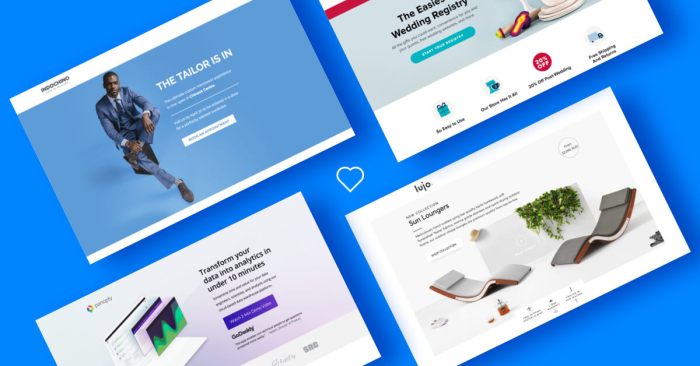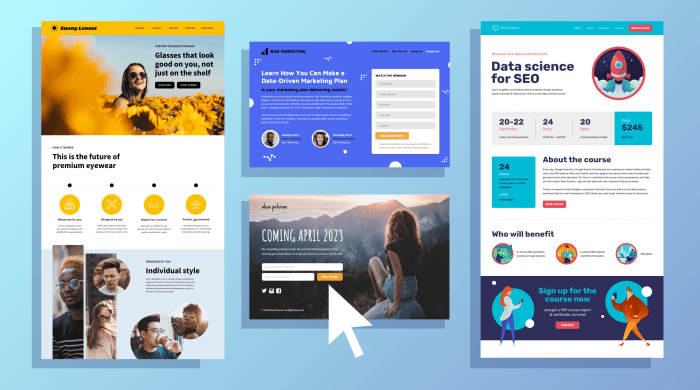Improving Landing Page Design dives into the essential elements of creating a captivating and effective landing page, focusing on enhancing user experience and maximizing conversion rates. Get ready to explore the world of digital marketing through the lens of design!
Let’s kick things off by understanding why landing page design is crucial and how it can directly impact the success of your digital marketing campaigns.
Importance of Landing Page Design

In the world of digital marketing, landing page design plays a crucial role in capturing the attention of website visitors and converting them into customers. A well-designed landing page can make or break a marketing campaign, impacting conversion rates significantly.
Impact on Conversion Rates, Improving Landing Page Design
A well-designed landing page with clear call-to-action buttons, engaging visuals, and compelling copy can lead to higher conversion rates. When visitors land on a page that is visually appealing and easy to navigate, they are more likely to take the desired action, such as making a purchase or signing up for a newsletter.
Role of User Experience
- Optimizing user experience is essential in shaping landing page design. A user-friendly layout, fast loading speed, and intuitive navigation can enhance the overall experience for visitors, increasing the chances of conversion.
- Understanding the target audience and their preferences is key in designing a landing page that resonates with users. By incorporating elements that cater to the needs and expectations of visitors, businesses can create a more personalized and engaging experience.
- Continuous testing and optimization based on user feedback and data analytics are crucial for improving landing page design. By analyzing user behavior and making data-driven decisions, businesses can refine their landing pages to maximize conversion rates and drive business growth.
Elements of an Effective Landing Page
Creating a successful landing page involves incorporating key components that attract and engage visitors. From compelling visuals to clear call-to-action buttons, each element plays a crucial role in converting leads into customers.
Clear Call-to-Action Buttons
One of the most important aspects of a landing page is the presence of clear and prominent call-to-action buttons. These buttons guide visitors on what action to take next, whether it’s signing up for a newsletter, requesting a demo, or making a purchase. By using action-oriented language and placing the buttons strategically on the page, you can increase the chances of conversion.
- Ensure that the call-to-action buttons stand out visually with contrasting colors and bold typography.
- Keep the text on the buttons concise and compelling, such as “Get Started” or “Download Now.”
- Place the buttons above the fold so that they are easily accessible without the need to scroll.
Optimizing Loading Speed
In addition to a clear call-to-action, optimizing the loading speed of your landing page is crucial for providing a seamless user experience. Slow-loading pages can lead to high bounce rates and lower conversions, as visitors are less likely to wait for a page to load fully.
- Compress images and videos to reduce file sizes and improve loading times.
- Minimize the use of plugins and scripts that can slow down your page.
- Utilize browser caching to store static elements and speed up loading for returning visitors.
Visual Design Strategies

When it comes to creating an effective landing page, visual design plays a crucial role in capturing the attention of visitors and encouraging them to take action. From color psychology to the balance between text and visuals, here are some key strategies to keep in mind.
Color Psychology in Landing Page Design
Color psychology is a powerful tool that can influence the emotions and behavior of visitors to your landing page. By selecting the right colors, you can evoke specific feelings and convey the right message to your audience. For example, blue is often associated with trust and security, while red can create a sense of urgency. It’s important to choose colors that align with your brand and the desired response from your visitors.
Selecting Images and Graphics
Images and graphics are essential elements of a visually appealing landing page. When choosing visuals, make sure they are high-quality, relevant to your message, and resonate with your target audience. Avoid using generic stock photos and opt for custom images that showcase your product or service in an engaging way. Remember, visuals should complement your text and help communicate your value proposition effectively.
Balance Between Text and Visuals
Finding the right balance between text and visuals is key to creating a visually appealing landing page. Too much text can overwhelm visitors and distract them from the main message, while too few visuals can make the page appear dull and uninteresting. Aim for a harmonious blend of text and visuals that guides visitors through the page and highlights key information. Use visuals to enhance the overall design and reinforce your messaging without overshadowing the text.
Mobile Responsiveness: Improving Landing Page Design
In today’s digital age, mobile responsiveness is crucial in landing page design. With the increasing number of users accessing websites on their mobile devices, it is essential to ensure that your landing page is optimized for mobile viewing.
Importance of Mobile Responsiveness
Ensuring that your landing page is mobile-friendly is not just about accommodating users on different devices, but it also impacts your overall user experience. A mobile-responsive landing page can improve engagement, reduce bounce rates, and ultimately lead to higher conversions.
- Optimize for Different Screen Sizes: Make sure your landing page looks good and functions well on various screen sizes, from smartphones to tablets.
- Fast Loading Speed: Mobile users expect quick load times, so optimize images and minimize unnecessary elements to improve speed.
- Easy Navigation: Simplify navigation by using clear menus, buttons, and forms that are easy to interact with on a smaller screen.
- Responsive Design: Utilize responsive design techniques to ensure that your landing page adjusts seamlessly to different devices without compromising the layout or content.
Impact on User Engagement and Conversions
A mobile-responsive landing page can significantly impact user engagement and conversions. By providing a seamless experience across devices, you can increase user satisfaction and encourage visitors to take action.
Studies show that 57% of internet users say they won’t recommend a business with a poorly designed mobile site.
- Improved User Experience: A mobile-responsive design enhances user experience, making it easier for visitors to navigate your landing page and find the information they need.
- Higher Conversion Rates: With a mobile-friendly landing page, you can potentially increase conversion rates as users are more likely to engage with your content and complete desired actions.
- Benefits: Google prioritizes mobile-friendly websites in search results, so having a mobile-responsive landing page can also boost your rankings and visibility.
